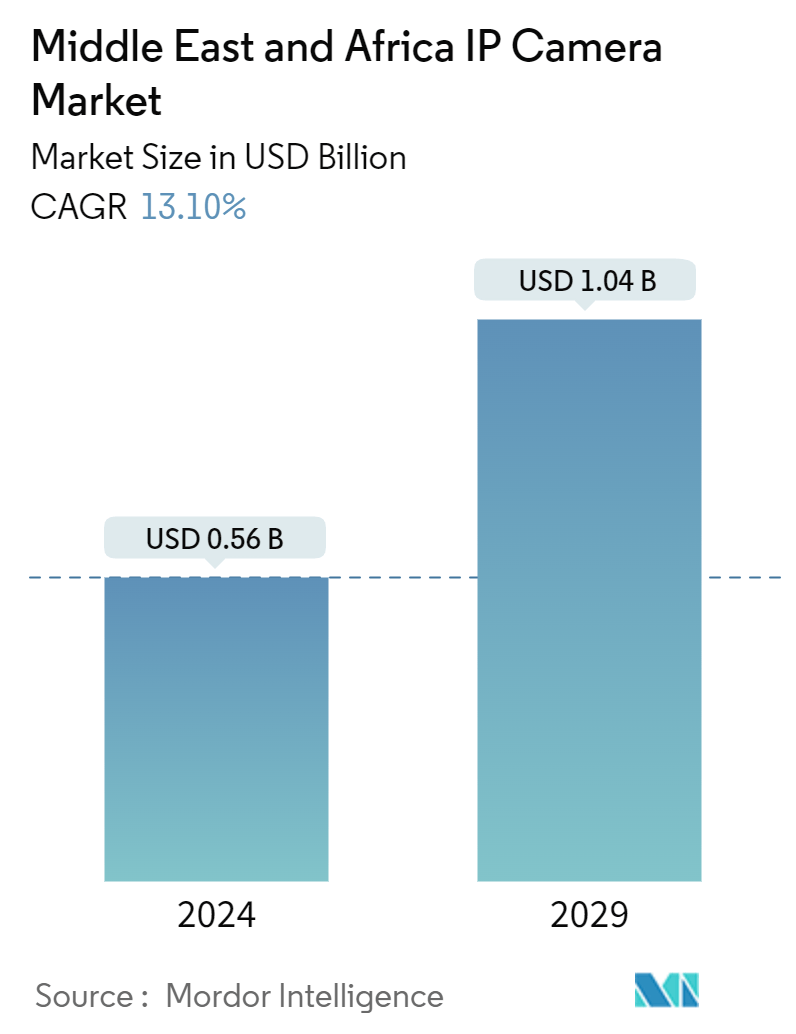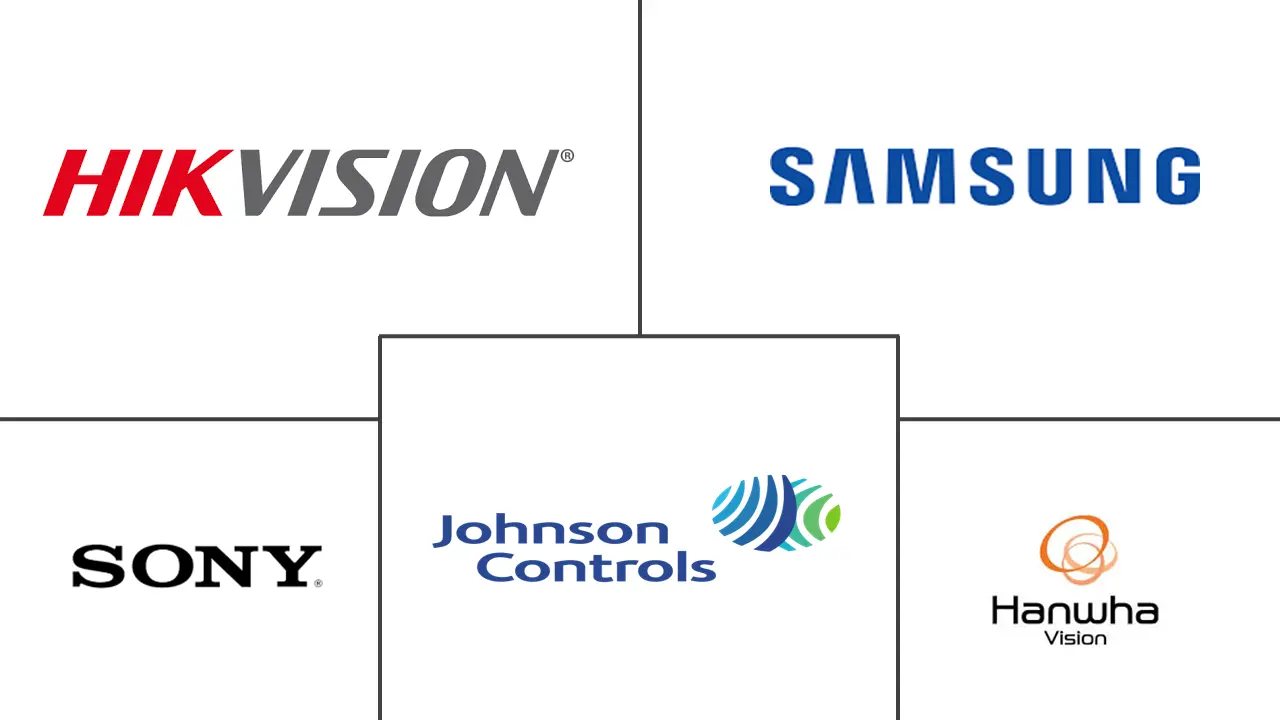Market Size of Middle East And Africa IP Camera Industry

| Study Period | 2019 - 2029 |
| Base Year For Estimation | 2023 |
| Market Size (2024) | USD 0.56 Billion |
| Market Size (2029) | USD 1.04 Billion |
| CAGR (2024 - 2029) | 13.10 % |
| Market Concentration | Low |
Major Players
*Disclaimer: Major Players sorted in no particular order |
Middle East And Africa IP Camera Market Analysis
The Middle East & Africa IP Camera Market size is estimated at USD 0.56 billion in 2024, and is expected to reach USD 1.04 billion by 2029, growing at a CAGR of 13.10% during the forecast period (2024-2029).
- The Middle East and Africa IP camera market is anticipated to experience growth between 2024 and 2029 due to the rising utilization of advanced technologies to combat increasing security threats, government regulations requiring security enhancements, and the implementation of large infrastructure development projects.
- Due to the substantial increase in commercial development, there has been a surge in the need for IP cameras in the region. Moreover, with the ongoing expansion of infrastructure, the population in malls, hotels, and amusement parks is expected to grow, leading to an increased demand for various security devices, thus supporting the market growth.
- For instance, in September 2023, DAMAC Group announced the opening of DAMAC Mall, a new retail and leisure destination in Dubai. The shopping center showcases a vast 110,000 sq. ft area that combines retail, hospitality, leisure, and entertainment options. It is created to serve as a central location for premium shopping experiences.
- The market will witness high growth as the regional government is currently prioritizing the installation of security cameras to bolster citizen safety and diminish crime rates. This increases the demand for IP cameras in the Middle East and Africa.
- For instance, in February 2024, the Gauteng Provincial Government announced that it had received a boost of 6000 CCTV cameras to fight crime. CCTV cameras are being placed in business districts, townships, areas with high crime spots, schools, roads, and other public places. The initiative to combat crime through the utilization of technology is a collaborative effort among the Department of e-Government, Community Safety, and the South African Police Services (SAPS). Its purpose is to enhance existing crime-fighting endeavors by offering CCTV cameras and advanced surveillance drones, distributing panic buttons to facilitate access to assistance from law enforcement personnel in times of distress, and implementing tracking devices on vehicles.
- Nevertheless, the expansion of the market is impeded by obstacles such as elevated investment expenses and a scarcity of expertise in IP camera operations. Furthermore, the increasing apprehensions about data privacy among consumers are adversely impacting the market's progress. Not only are individuals refraining from choosing these solutions, but governments in the region are also imposing regulations on data usage and imposing limitations on the storage of such data.
- Macroeconomic factors, like government regulations concerning the import and export of IP cameras, have a substantial influence on the accessibility and dependability of such devices. These regulations differ across nations, frequently necessitating thorough certifications, testing, and compliance with particular criteria. Despite their intention to guarantee safety and quality, these regulations can present notable obstacles for producers, suppliers, and consumers. Import/export regulations may delay IP camera availability, impeding their prompt implementation in different end-user sectors.
Middle East And Africa IP Camera Industry Segmentation
The study tracks the revenue accrued through the sale of IP cameras by various players in the Middle East and Africa market. The study also tracks the key market parameters, underlying growth influencers, and major vendors operating in the industry, which supports the market estimations and growth rates between 2024 and 2029. The report’s scope encompasses market sizing and forecasts for the various market segments.
The Middle East and Africa IP Camera market is segmented by type (fixed, pan-tilt-zoom (PTZ), and varifocal), end-user industry (residential, commercial, industrial, and government and law enforcement), and country (United Arab Emirates, Saudi Arabia, South Africa, and Rest of Middle East and Africa). The market sizes and forecasts are provided in terms of value (USD) for all the above segments.
| By Type | |
| Fixed | |
| Pan-Tilt-Zoom (PTZ) | |
| Varifocal |
| By End-user Industry | |
| Residential | |
| Commercial (BFSI, Education, Healthcare, Real Estate, and Retail) | |
| Industrial | |
| Government and Law Enforcement |
| By Country | |
| United Arab Emirates | |
| Saudi Arabia | |
| South Africa |
Middle East And Africa IP Camera Market Size Summary
The Middle East and Africa IP Camera market is poised for significant growth over the forecast period, driven by the increasing adoption of advanced technologies to address security concerns, regulatory mandates for enhanced security measures, and large-scale infrastructure projects. The surge in commercial development, particularly in regions like Saudi Arabia and the UAE, has led to a heightened demand for IP cameras. This demand is further bolstered by the expansion of infrastructure, which is expected to increase foot traffic in malls, hotels, and amusement parks, thereby necessitating robust security solutions. Government initiatives, such as the installation of CCTV cameras in high-crime areas and public spaces, underscore the region's commitment to improving citizen safety and reducing crime rates. However, challenges such as high investment costs, a lack of expertise in IP camera operations, and data privacy concerns pose obstacles to market expansion.
The market landscape is characterized by the presence of several key players, including Hanwha Vision America, Hangzhou Hikvision Digital Technology Co. Ltd, Samsung Electronics Co. Ltd, Johnson Controls, and Sony Corporation, who are actively working to expand their market share through strategic collaborations and innovative product offerings. The integration of cutting-edge technologies like facial recognition, video analytics, and machine learning is expected to enhance security and operational efficiency, aligning with smart city initiatives and data protection regulations in the UAE. The government's focus on diversifying the economy away from oil dependency by promoting non-oil industries such as hospitality and retail further supports the market's growth. As the demand for IP cameras in various sectors, including education and public safety, continues to rise, the market is set to experience robust expansion, despite regulatory and economic challenges.
Middle East And Africa IP Camera Market Size - Table of Contents
-
1. MARKET INSIGHTS
-
1.1 Market Overview
-
1.2 Industry Attractiveness - Porter's Five Forces Analysis
-
1.2.1 Threat of New Entrants
-
1.2.2 Bargaining Power of Consumers
-
1.2.3 Bargaining Power of Suppliers
-
1.2.4 Threat of Substitute Products
-
1.2.5 Intensity of Competitive Rivalry
-
1.2.6 Threat of New Entrants
-
-
1.3 Industry Value Chain Analysis
-
1.4 Technological Advancements
-
-
2. MARKET SEGMENTATION
-
2.1 By Type
-
2.1.1 Fixed
-
2.1.2 Pan-Tilt-Zoom (PTZ)
-
2.1.3 Varifocal
-
-
2.2 By End-user Industry
-
2.2.1 Residential
-
2.2.2 Commercial (BFSI, Education, Healthcare, Real Estate, and Retail)
-
2.2.3 Industrial
-
2.2.4 Government and Law Enforcement
-
-
2.3 By Country
-
2.3.1 United Arab Emirates
-
2.3.2 Saudi Arabia
-
2.3.3 South Africa
-
-
Middle East And Africa IP Camera Market Size FAQs
How big is the Middle East And Africa IP Camera Market?
The Middle East And Africa IP Camera Market size is expected to reach USD 0.56 billion in 2024 and grow at a CAGR of 13.10% to reach USD 1.04 billion by 2029.
What is the current Middle East And Africa IP Camera Market size?
In 2024, the Middle East And Africa IP Camera Market size is expected to reach USD 0.56 billion.

